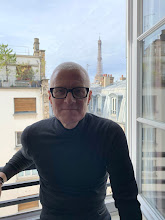 Aldeburgh in Suffolk has long been a special place for me. The home of Benjamin Britten and of Adnams bitter (well, almost - it is brewed just down the coast in Southwold, where my grandmother had a house, which was more or less next door to the brewery), it sits squat against the North Sea coast, huddling bravely against the wind and the sea that batters and erodes this resilient but ever shifting stretch of shore. The sound of the shingle being dragged constantly backwards and forwards in the undertow of the breaking waves characterises the beach at Aldeburgh and provides it with its own peculiar kind of music. Britten's 'Four Sea Interludes', from his opera Peter Grimes, are seen by many as one of the most perfect musical evocations of this moody, cold and often grey expanse of water. Although Aldeburgh is a wonderful place to holiday during the summer months when one can often experience a more benign sea, blue and bathed in sunlight, it is the darker, autumnal and winter Aldeburgh that has stayed with me; the town as last stand against the watery invader that seeks to grasp it and pull it into the sea as it did with the medieval port of Dunwich a few miles away. I haven't been to Aldeburgh for some time and so had not yet had a chance to see Maggi Hambling's surprisingly controversial sculpture, 'Scallop', which sits on Aldeburgh beach, mid way between the town and its neighbour, Thorpeness. Apparently the scallop has been daubed with graffiti on a regular basis with many locals objecting not so much to the artefact itself but to its positioning on an open and unspoilt section of beach, designated as an area of outstanding natural beauty (read about this here). While the sculpture does have a rather strange silhouette as one approaches it along the beach from Aldeburgh, once close up it does impress. For me, its shape and colour reflects the swell and hue of the sea, while associations with sound are manifest too, as the tubular ridges evoke the hollow sections of brass musical instruments. The text that is etched into the steel - 'I hear those voices that will not be drowned' - comes directly from Peter Grimes and serves as a powerful reminder that the sea along this coast has claimed many lives over the centuries, just as the ever present Aldeburgh Lifeboat reminds us of the precariousness of the fisherman's profession and the dangers of the sea. Unfortunately, Adnams doesn't travel well (it really is a wonderful beer when drunk sitting on the Aldeburgh sea wall) and perhaps this scallop, not found naturally on this stretch of coast, has ultimately travelled rather too far for some...
Aldeburgh in Suffolk has long been a special place for me. The home of Benjamin Britten and of Adnams bitter (well, almost - it is brewed just down the coast in Southwold, where my grandmother had a house, which was more or less next door to the brewery), it sits squat against the North Sea coast, huddling bravely against the wind and the sea that batters and erodes this resilient but ever shifting stretch of shore. The sound of the shingle being dragged constantly backwards and forwards in the undertow of the breaking waves characterises the beach at Aldeburgh and provides it with its own peculiar kind of music. Britten's 'Four Sea Interludes', from his opera Peter Grimes, are seen by many as one of the most perfect musical evocations of this moody, cold and often grey expanse of water. Although Aldeburgh is a wonderful place to holiday during the summer months when one can often experience a more benign sea, blue and bathed in sunlight, it is the darker, autumnal and winter Aldeburgh that has stayed with me; the town as last stand against the watery invader that seeks to grasp it and pull it into the sea as it did with the medieval port of Dunwich a few miles away. I haven't been to Aldeburgh for some time and so had not yet had a chance to see Maggi Hambling's surprisingly controversial sculpture, 'Scallop', which sits on Aldeburgh beach, mid way between the town and its neighbour, Thorpeness. Apparently the scallop has been daubed with graffiti on a regular basis with many locals objecting not so much to the artefact itself but to its positioning on an open and unspoilt section of beach, designated as an area of outstanding natural beauty (read about this here). While the sculpture does have a rather strange silhouette as one approaches it along the beach from Aldeburgh, once close up it does impress. For me, its shape and colour reflects the swell and hue of the sea, while associations with sound are manifest too, as the tubular ridges evoke the hollow sections of brass musical instruments. The text that is etched into the steel - 'I hear those voices that will not be drowned' - comes directly from Peter Grimes and serves as a powerful reminder that the sea along this coast has claimed many lives over the centuries, just as the ever present Aldeburgh Lifeboat reminds us of the precariousness of the fisherman's profession and the dangers of the sea. Unfortunately, Adnams doesn't travel well (it really is a wonderful beer when drunk sitting on the Aldeburgh sea wall) and perhaps this scallop, not found naturally on this stretch of coast, has ultimately travelled rather too far for some...
Omnishambles at the BBC
2 years ago

















